PLACES IN THE NARA AREA

Five-Story Pagoda at Horyuji Temple Omiwa Shrine (in Sakuria south Nara) houses a deity of sake brewing. Leaves from the Japanese cedars that grow on the shrine grounds were traditionally hung from all the sake breweries in Japan to mark the arrival of the year's first batches of sake. The shrine also boasts the tallest torii gate in Japan (32.2 meters high).
Hasedera Temple (two stops form Sakurai on the Kintensu Odaka line) was built in the mountains, according to legend, on the orders of Emperor Shomu. Enshrined in the temple is 25-foot-tall, 11-faced statue of Kannon. The 399 steps that lead up to the temple is lined on both sides by 7,000 red and white peonies that bloom in April and may.
Muroji Temple (in Muromura south of Nara) is regarded as one of the beautiful and beautifully situated temples in Japan. Nestled in the mountains of Nara, it is five stories high and was first built in A.D. 780 and was last rebuilt after a typhoon in 1998. A 30 minute trek will take you several pyramid-shaped sculptures by Israeli artist Dani Karavan in the Muro Art Forest.
Imaichi (south of Nara, accessible from Kintensu Yamato-Yagi Station and JR Unebi Station) features a number of streets with classic machiya houses and traditional residences. Several of the houses allow visitors to stroll around inside and see what the interior of a machiya houses is like. Some sell stuff: sake, souvenirs, snacks. Imaichi is a pleasant place to while away a couple of hours and is visited mostly by Japanese tourists.
Nara Prefecture covers 3,691 square kilometers (1,425 square miles), is home to about 1.4 million people and has a population density of 370 people per square kilometer. Nara is the capital and largest city, with about 360,000 people. It is in the Kansai area near Osaka and Kyoto on the central part of Honshu island and has seven districts and 39 municipalities.
HORYUJI TEMPLE
Horyuji Temple (eight miles southwest of Nara) contains what is believed to be the oldest wooden temple building in the world. Covering 14.5 hectares and said to be founded in 607 by Prince Shotoku, the great protector and spreader of Japanese Buddhism, the site contains many treasured buildings, sculptures and pictorial art objects.
Horyuji Temple is the most precious places in Japan from the points of view of history, architecture, art and aesthetics. Its contains 45 buildings, dating from the 7th to 17th centuries, include some of the worlds oldest wooden structures – along with the very oldest, the Five-Storied Pagoda. Prince Shotoku was regent for Empress Suiko and sponsor of the ‘Seventeen-Article Constitution’.
Horyuji Temple was the first temple in Japan to be designated a UNESCO World Heritage Site (in 1993). It also houses one of Japan's greatest collections of ancient art, including the earliest works of sculpture, created by Korean artisans in the Asuka Period, 38 national treasures and 153 nationally important cultural properties. There is some debate as to whether the temple complex is true to its original layout
Horyuji is located in northwestern Nara in an a town originally known as Ikarugacho, said to have been founded by Prince Shotoko. The temple is located in a scenic mountainous area. There is a great collection of Buddhist art along with ancient burial mounds, including Fujinoki Tumulus. Websites: Wikipedia Wikipedia ; Photos taleofgenji.org UNESCO World Heritage site: UNESCO website Getting There: Visit Nara visitnara.jp
Buddhist Monuments in the Horyu-ji Area: UNESCO World Heritage Site
The Buddhist Monuments in the Horyu-ji Area were declared a UNESCO World Heritage Site in 1993. According to UNESCO: “There are around 48 Buddhist monuments in the Horyu-ji area, in Nara Prefecture. Several date from the late 7th or early 8th century, making them some of the oldest surviving wooden buildings in the world. These masterpieces of wooden architecture are important not only for the history of art, since they illustrate the adaptation of Chinese Buddhist architecture and layout to Japanese culture, but also for the history of religion, since their construction coincided with the introduction of Buddhism to Japan from China by way of the Korean peninsula.” [Source: UNESCO]
The Buddhist Monuments in the Horyu-ji Area “consists of forty-eight ancient wooden structures located at the two temples sites, twenty-one at Horyu-ji temple and Hokki-ji temple. The Horyu-ji temple covers an area of 14.6 hectares and the smaller Hokki-ji Temple 0.7 hectares. The two sites are surrounded by a single buffer zone measuring 570.7 hectares.
“The Buddhist Monuments in the Horyu-ji Area are the earliest Buddhist monuments in Japan, dating from shortly after the introduction of Buddhism to the country, and had a profound influence on subsequent religious architecture. Eleven structures on the temple sites date from the late-7th or 8th century making them some of the oldest surviving wooden buildings in the world. Although a fire destroyed the original Horyu-ji buildings in 670, structural remains survive below ground in the precinct known as Wakakusa Garan to the south-east of the later West Temple (Sai-in). Rebuilding commenced almost immediately and continued into the early years of the 8th century.
“The structures are based on the Chinese bay system, a modified version of post-and-lintel construction with intricate bracketing designed to transfer the weight of the heavy tiled roof down to the massive wooden supporting columns. They are especially noteworthy for the skilful use of entasis on the columns and their cloud-shaped brackets. These masterpieces of wooden architecture are important not only for the history of art, since they illustrate the adaptation of Chinese Buddhist architecture and layout to Japanese culture, but also for the history of religion, since their construction coincided with the introduction of Buddhism to Japan from China by way of the Korean peninsula. From its foundation Horyu-ji always enjoyed the protection of the imperial family. In addition, the cult of Prince Shotoku, which flourished after the 12th century, attracted many pilgrims, and as a result Horyu-ji was always immaculately maintained and conserved.”
The site is important because: 1) The Buddhist Monuments in the Horyu-ji Area are masterpieces of wooden architecture, both in overall design and in decoration. 2) These are the earliest Buddhist monuments in Japan, dating from shortly after the introduction of Buddhism to the country, and had a profound influence on subsequent religious architecture. 3) The Horyu-ji monuments represent the adaptation of Chinese Buddhist architecture and temple layout to Japanese culture and the subsequent development of a distinct indigenous style. 4) The introduction of Buddhism into Japan and its promotion by Prince Shotokumarks a significant stage in the spread of Buddhism over this cultural zone.
Temples, Pagodas and Shrines at Horyuji
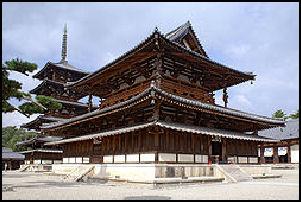
The Horyuji Temple grounds are divided into east (Saiin Temple) and west (Toin Temple). The pagoda, Chumanar gate and the Temple of Horyu are the oldest wooden buildings. Among the 55 buildings, which have been declared National Treasures, are the famous Hall of Dreams (Yumedono) , the covered gallery of the Saiian Temple, and 130-foot-high, five-tier pagoda.
The main hall contains a triad of the Buddha Sakyamuni. Inside the Treasure House are the Kudara Kannon and two miniature shrines: the Tamamushi Shrine (once covered with wing shells of jeweled beetles) and the Shrine of Lady Tachibana. Hinoko cypress and Japanese cedar were used to build te main hall, the five-story pagoda and in the inter gate are believed to have been cut down between 668 and 685, which would make them the world’s oldest wooden structures Their ages were determined bu matching the growth rings of the timbers with information gleaned from historical records.
Gojunoto (Five-Story Pagoda) (in the western precinct at Horyuji) is the world's oldest wooden temple and the world's oldest surviving wooden structure. It was originally built in 607. Some have argued it had been unchanged since then, An investigation of timbers use to build the structure indicate the temple was rebuilt after a fire in 670. Examination of tree rings on the timber in the present structure indicate the trees were felled in 663, 631 and 624. Five-Story Pagoda is regarded earthquake-resistant. The five stories oscillate in opposed phases when there are tremors. There is no evidence of the structure ever collapsing. The same techniques are used in modern buildings.Four stone demons — located at he four corners of the upper part of the structure’s lowest roof “hold up” the pagoda.
Chuguji Temple (near Horyuji ’s East Temple) is a convent noted for its art objects, chief among them are a fragment of the oldest embroidery in Japan and the beautiful wooden statue of Miroku-bosatsu. There are some very pleasant walks in this area. A ten minute walk will take you to Horin-ji Temple. Another 10 minute walk will take you Hokkeji Temple, with a famous statue of Kannon, the eleven-faced Goddess of Mercy. Two minutes from there is Jiko-in Temples that features a pleasant garden and a high admission fee.
Art from Horyuji
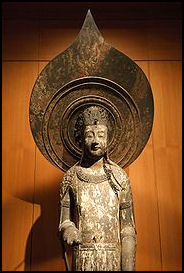
replica of the
Kudara Kannon 1 Horyuji temple was damaged by fire in 1949. Many of the temple’s delicate, 1,200-year-old works of art — mostly bronze Buddha and bodhisattva statues, nimbuses and reliefs — were placed in the Gallery of Horyuji in the Tokyo Nation Museum. Many of the treasures still in the hands of Horyuji are in such delicate condition they can only displayed on certain special occasions, only for a few hours a day.
The statue kept on Yumeddono is sacred and thought to be an image of Prince Shotoku himself. In 1894, the statue was brought out for the first time in 200 years. According to an American scholar who saw it said it was wrapped in “some 500 yards of cloth” and was compared in quality to a Greek statue. The scholar was taken by the statue’s “quite, mysterious smile...not unlike da Vinci’s Mona Lisa’s.”
Chuguji Temple contains the Miroku-Bosatsu statue, a 7th century wooden Buddha renowned for its serenity; and an embroidered mandala believed to date back to the 7th century and believed to be the oldest example of visual art in Japan.
Gallery of Horyuji (part of the Tokyo National Museum) is dedicated to preservation of 319 delicate, 1,200-year-old works of art — mostly bronze Buddha and bodhisattva statues, nimbuses, reliefs, scrolls and masks — taken from Nara's Horyuji temple after it was damaged by fire in 1949. In the past the works were only displayed on Thursday unless the humidity level was too high and then they weren't shown at all. In 1999, a new facility was opened that allows the works to be shown every day.
The dramatic approach to The Gallery of Horyuji Treasures foreshadows the equally dramatic use of space and lighting that awaits inside the spacious foyer, halls, and galleries that give an otherworldly experience to visitors. Designed by Yoshio Taniguchi and opened in 1999, the museum houses over 300 valuable pieces dating from the 7th to the 8th century that were gifted from the Horyuji Temple in Nara to the imperial family in 1878, and then transferred to the museum after World War II. Boasting state-of-the-art conservation technology, the museum also has a digital archive featuring the entire collection. Contact: 13-9 Ueno Park, Taito-ku, Tokyo 110-8712 +81-3-5777-8600 Tokyo
Conservation of Buddhist Monuments in the Horyu-ji Area
According to UNESCO: “The boundaries of the property respect the historic outline of the temple grounds and include all the necessary monuments to demonstrate the adaption of Chinese Buddhist architecture and temple layout as well as its influence on subsequent religious architecture in Japan. The property area, with its forty-eight component parts, maintains a good state of preservation and has adequate protection, thus, the property’s integrity is ensured in the contexts of both wholeness and intactness.
”The conservation work that has been carried out since 1895 has met the highest standards of contemporary conservation practice. From 1934 onwards, new techniques have been developed for the conservation of wooden structures, and especially in the case of interventions involving dismantling and reconstruction, which established sound precedent for the conservation of wooden buildings.
”The Japanese conservation practice conforms to established principles of authenticity in design, materials, techniques, and environment. Minor changes made to buildings have allowed them to retain their historic form and features, and safeguard the original character. Damaged wooden members are carefully replaced only when absolutely necessary and the process follows traditional techniques. The use of new materials is rigorously controlled. Special attention is paid to the use of traditional tools and techniques in conservation work. Most of the forty-eight buildings are in the original locations and have retained their historic settings. In general, the property retains a high level of authenticity in terms of form/design, materials/substance, traditions/techniques and location/setting.
”The forty-eight buildings that comprise the property are all protected under designation as National Treasures and Important Cultural Properties in accordance with 1950 Law for the Protection of Cultural Properties. The areas of the property (15.3 ha) are also protected under designation as a Special Historic Site under the 1950 Law. Under the law, proposed alterations to the existing state of the property are restricted and any alteration must be approved by the national government.
”The property is owned by theHoryu-jiReligious Organization and the Hokki-jiReligious Organization, which are responsible for its management. Several qualified conservation architects of the Nara Prefectural Board of Education are stationed at the site of Horyu-ji temple to plan and supervise repair work. As all of the monuments and their surrounding buildings are made of wood, each of the monuments is equipped with automatic fire alarms, fire hydrants and lightning arresters. In addition, private fire brigades are organized by Horyu-jiand Hokki-ji, which work in cooperation with public fire offices. The Agency for Cultural Affairs, Nara Prefecture and Ikaruga Town provide the property owners with both financial assistance and technical guidance for adequate preservation and management.”
Asuka
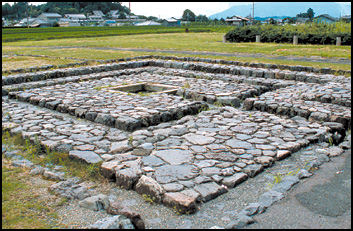
Itabuki Asuka (south of Nara, 45 minutes by train from Osaka) is a wonderful historical area with ancient tombs, Kofun burial mounds, mysterious carved stones, remains of imperial palaces, and temple and shrines, which commemorate important sites. Palaces includes Toyoura no Miya, the residence of Empress-regnant Suiko, used between 592 and 603, and Asuka Kiyomihara no Miya, the residence of Emperor Tenmu and Empress-regent Jito from 672 to 694.
The Asuka-Fujiwara area of Nara Prefecture is believed to be the starting point of Japan as a law-governed nation. Designated as a World Heritage Site, it stretches through a village and two cites — Asuka-mura, Kashihara and Sakurai — and covers an area of 24 square kilometers. Hiking rails and bike paths run through the farmland around the area. Many people tour the area on bicycles which can be rented in front of Kintensu Asuka Station.
Asukamura villages covers 2,400 hectares and embraces the historic sites of Ishibutal, Takamatsuzuka and the Kitora ancient tombs. The main village in the Asuka area, it was the capital of ancient Japan from A.D. 592 to 710. During this period eight emperors, starting with the Empress Suiko, ran the state until the capital was moved to Heijokyo (Nara). About 7,000 people live in the village today. Laws prevent them from developing the area in unsightly ways or damaging agriculture or forestry. Many of the residents are very old.
The ruins of the city of Fujiwara, where Empress Jito moved the capital form the Asuka area are located in Kashihara. Japan’s first national law, Taiho Ritsuryo, was established in 701 in Fujiwara. Kashihara is home to three “mountains” known as Yamato SanzanNebiyama, Miminashiyama and Amenokaguyama. Though these “mountains” are less than 200 metes high there were mentioned in many poems in the “Manyoshu”, Japan’s oldest anthology of poems. Websites: Asuka Park asuka-park.go.jp ; Asuka Historical Museum asukanet.gr.jp ; Visit Nara visitnara.jp; UNESCO World Heritage sites ; Map: Asuka Cycle Rental k-asuka.com ; Getting There: Asuka is accessible from Nara by train
History of Asuka
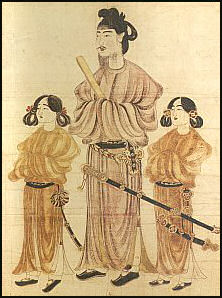
Prince Shotoku The Asuka Period (A.D. 592-700), a little-understood period when Japanese culture was developing and defining itself and the first powerful centralized Japanese state was established. Asuka is the name of ancient city (near Nara), where the kingdom was centered. The capital of Japan from 694 to 710 was nearby in Fujiwarakyu, in Kashihara, Nara.
The Asuka Period began with accession of Empress Suiko to the Japanese throne in 592 and the establishment of Toyura Palace. The most important Asuka ruler was Shotoku Taishi (born in 574, ruled 593-622). Regarded as the "father of Japanese Buddhism," he made Buddhism the state religion by constructing major Buddhist temples such as Horyu-ji near Nara. His was goal was to create a harmonious society.
Shotoku Taishi (Prince Shotoku) also dispatched an official diplomatic delegation to China, established the Seventeen Article Constitution in A.D. 592 and brought together the priest-chiefs of the major clans into a somewhat centralized government based on the Chinese model. He began asserting Japan's power, and once wrote a letter to the Emperor of China, addressing to "from the Emperor of the Rising Sun to the Emperor of the Setting Sun." Under Shotoku Buddhism became the state religion, scriptures, art and craftsmen were brought in from Korea and Japanese monks were sent abroad to study. Temples were founded, monks were ordained and ceremonies were held publically.
Mahayana (Greater Vehicle) Buddhism was introduced in the Asuka period. Mahayana religious themes would endure for over 500 years. The introduction of Mahayana Buddhism marked the beginning of the development of Japanese fine arts. At this time artisans turned their attention from ceramics and metalworks to Buddhist images, namely sculptures.
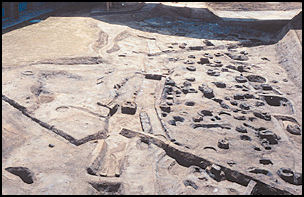
palace remains The oldest minted coins found in Japan were unearthed at the ancient site of Fujiwarakyu, the ancient capital from 694 to 710, in Kashihara, Nara. The Nihon Shoki — an ancient historical text — contains reference to the of coins in A.D. 683. Among the important cultural legacies of the Asuka period is “Manyoshu”, a literary treasure containing more than 4,500 poems which provide much evidence on how people lived at that time.
A large Asuka period pond, covering 5,000 square meters, found at Asukamura, Nara Prefecture, and believed to belong to palace of Emperor Temmu, is similar to Silla dynasty ponds found in South Korea in the 7th and 8th centuries. Seventh and 8th century tombs in Asuka have revealed images of creatures associated with the points of the Chinese and Korean compass: a blue dragon for east, a white tiger for west, an imaginary Chinese bird for south, and a turtle and snake for north.
Many historian believe these tombs provide proof that rulers in the Asuka, and possibly Yamato, periods were either Koreans or Chinese or strongly influenced by Korean or Chinese culture. Many Koreans believe they offer proof that Japanese Imperial family was founded by a Korean clan, something that Japanese nationalists vehemently deny is possible.
The earliest works of sculpture were created by Korean artisans. Example of their work remain at Horyuji Temple in Nara and Koryuji Temple in Kyoto. In 1972, archaeologists discovered well-preserved murals inside the Takamatsu tomb at the Asuka archeological site. Dated to the end of the seventh century, the murals contained images of tigers, dragons, and star constellations like those found in Korean and Chinese tombs. The people in some of the murals are wearing Korean-style clothes.
See Separate Articles ASUKA PERIOD (A.D. 538 TO 710) factsanddetails.com ; EARLY BUDDHISM AND POLITICAL STRUGGLES IN ASUKA-ERA JAPAN factsanddetails.com ; PRINCE SHOTOKU factsanddetails.com ; TAIKA REFORMS AND EMPERORS TENJI AND TENMU factsanddetails.com ; ASUKA GOVERNMENT AND ECONOMY AND THE RITSURYO SYSTEM factsanddetails.com ; ASUKA, FUJIWARA AND ASUKA-ERA CITIES AND TOMBS factsanddetails.com ; CULTURE AND LITERATURE FROM THE ASUKA PERIOD (A.D. 538 TO 710) factsanddetails.com ; ASUKA ARCHITECTURE: PALACES AND BUDDHIST TEMPLES factsanddetails.com ; ASUKA ART factsanddetails.com
Asuka-Fujiwara: Archaeological Sites: Future UNESCO World Heritage Site?
Asuka-Fujiwara: Archaeological sites of Japan’s Ancient Capitals and Related Properties were nominated to be a UNESCO World Heritage site in 2007. According to a report submitted to UNESCO: “The site is comprised of a cluster of archaeological sites of ancient capitals in the Asuka region, where the imperial capital was located from the time of Empress Suiko's enthronement in 592 A.D. to its relocation to Heijōkyo (Nara) in 710, as well as the scenic areas and surrounding cultural landscape deeply associated with these archaeological sites of ancient capitals.[Source: Agency for Cultural Affairs Government of Japan]
“The component features of the site are principally the archaeological remains of palaces and residences of the emperor and imperial court and their related facilities (such as gardens, etc.) ; the site of Japan's first genuine capital city; and the remains of temples and burial mounds (the Takamatsuzuka Tomb with its famous wall paintings, the Kitora Tomb, and others) constructed in and around it for members of the imperial house, nobility, and other important personages during the century this area functioned as the capital. These remains have been preserved beneath the earth in good condition down to the present, and the structures and objects that have been excavated and surveyed to date convey vital insights into politics, society, culture, and religion during the period of the formation of the ancient Japanese state. Moreover, what these ruins tell us about the design philosophy, site planning, and construction technology of the era, coupled with the wall paintings and other artifacts found in specific archaeological remains are seen as displaying strong influence from mainland China and the Korean peninsula, clear evidence of the significance of cultural and technological contacts between Japan and the other countries of East Asia.
“Yamato Sanzan, a place of famous scenic beauty intimately associated with these archaeological sites, is also referenced frequently in the poems of the Man'yōshu, Japan's first poetry anthology, and is thus closely linked not only to the representative work of ancient Japanese literature, but also to the influence it exerted upon successive generations of artistic activity.
“Taken as a whole, the aforementioned archaeological and scenic sites, along with the surrounding natural environment, comprise a historical and cultural landscape of outstanding importance. Thus, this site, comprised of a cluster of archaeological sites and historic features that originate from close exchange with mainland China and the Korea peninsula, offers physical evidence for the process of the formation of the ancient Japanese state and also constitutes an extraordinarily valuable cultural landscape.”
Mysterious Stones at Asuka

turtle rock Asuka has many mysteriously-shaped stone objects, whose original purposes are still being debated by scholars. The Masuda Iwafune stone weighs 800 tons and has two 1.3-meter-deep square holes carved on the top. No one knows the purpose of the stone or how it got to the top of the hill where it stands.
The Kameisha Stone sits in the middle of a rice field. Some say it looks like a tortoise. Others say it looks like a toad. Both of these animal were sacred in the Asuka period yet the purpose of the stone remains unknown. There are four Saruisha (monkey-shaped stones) in Asuka. Three of these have a faces carved on both the front and back of the head.
The Sakafuneishi stone is a huge 5.5-meter-long granite rock with pits and channels chiseled out in it. Some have speculated it may have been used to make sake (rice wine). Others say the drainage gutters and round hollows on the top were part of a system of running water. A turtle-shaped stone excavated at the site in 2000 is believed to be part of a structure for pouring and storing water used by people to cleanse themselves before entering a palace. A pattern carved in the stone may be related the position of the sun during the spring and autumn equinoxes.
Burial Mounds and Temples at Asuka
Asuka also boasts a number of impressive burial mounds. Some have been left untouched while others have been carefully excavated. Centuries ago the earthen cover of Ishibutai tumulus was removed, exposing the tomb. At one tumulus, a large cover stone was separated from the base stone. The cover is known as Oni-no-Setchin (Ogre's toilet). The lay-out of the major tombs in the Asuka area seem in accordance with principles of feng shui (Chinese geomacy).
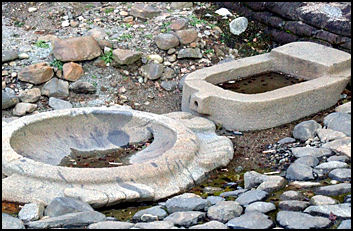
Ishibutai is regarded as the symbol of the Asuka area and is the largest square-shaped tomb in Japan. Its name literally means “stone stage tomb,” a named believed to have been derived from its shape. People can walk inside the tomb which is made of 2,300 tons of stone. One slab on the northen side of the roof weighs about 64 tons and one on the southern side is about 77 tons. The slabs were once part of the tomb itself and were exposed as soil eroded away,
The tomb is believed to have been built in the early 7th century for a powerful politician. The burial chamber is 7.8 meters long, 3.4 meters wide and 4.8 meter high. According to legend a fox transformed itself into a woman and performed dance on the tomb. Others claim that traveling performers used it as an impromptu stage.
Temples found at Asuka include Asukadera, the first true Buddhist Temple built in Japan, Okadera Tachibanadera, Kawaharadera. Tsubosakadera Temples contains a 20-meter-high marble Buddha. Japanese-language displays can be seen at the Asuka Historical Museum.
Asuka Itabuki no Miya ruins are believed to be to be the ruins of the palace of Emperor Kogyoku. The palace is believed to be where Soga bo Iruka, a powerful politician at the time, was assassinated, marking the start in A.D. 645 of the Taika Reforms — a political movement to restore power to the Imperial family form a powerful clan.
Kumedera (Kashihara-shi, Kume) is temple has been confused with the Okuyama Kumedera since olden times. The circumstances of its founding are unclear. Tile designs suggest that the temple was likely already in existence in the latter half of the 7th century. It is known to have flourished during the early Heian period. Remains include a rarely seen assemblage of boulders used as foundation stones for the pagoda. Atop the site of the original pagoda there rises a tahoto-style pagoda moved there during the Momoyama period (Late 16th century)
Takamatsuka Tomb
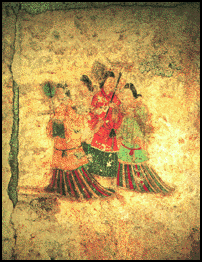
images of women in
Takamatsuka Tomb Takamatsuka Tomb (within Asuka) is one of the most important archeological discoveries ever made in Japan. In 1972, archaeologists excavated the tomb inside a 5-meter-high, 18-meter-in-diameter burial mound and discovered well-preserved murals inside and the bones of a male judged to be between 40 and 50 when he died.
Dated to the end of the seventh century, the murals contained images of a tiger, snakes, tortoise, dragon, and star constellations like those found in Korean and Chinese tombs. Some mural had images of people in Korean-style clothes, which seems to indicate that founders of Asuka were originally from Korea, something the Japanese are loath to admit.
The real tomb is sealed and investigated using cameras on fiberscope inserted through sealed openings in the tomb. But despite the best efforts the paintings have deteriorated and been invaded by mold. Ktiroa tom, built around the same time with tomb paintings, is located about one kilometer from Takamatsuzuka tomb. It was discovered in 1983.
A detailed replica of the real Takamatsuzuka tomb, nearly as good as the real thing, has been built nearby and it is open to visitors. In a display case are copies of objects that were found in the tomb: fragments of gold-leaf-covered lacquered wooden coffin, coffin fittings,, copper nails, sword fittings, metal pendants, beads and a mirror with a lion of grape motif.
In the mid 2000s, Takamatsuzuka tomb was dismantled, The four panels, measuring 2.65 meters long, 1.03 meters wide and 1.13 metes tall, were moved front their original location and preserved.
Kashihara (near Asuka) is the home of some of the world’s oldest toilets. The remains of 50 toilets were found in Fujiwarakyo (present-day Kashihara, Nara Prefecture), the capital of Japan from 694 to 710. There were of two types: simple holes in the ground and primitive “flush” toilets set over specially dug gutters. Both types were constructed in such a way that their users faced north
Hiking Mountains in the Kansai Area
Hiking Mountains in the Kansai Area include Mt. Hiei and Enryaku-ji Temple, which can be reached by foot or hiking trail. It is possible to take a bus and hike up to Mt. Hiei from the Kyoto side and hike down on the Lake Biwa side and take the train home. The twin peaks of Mt. Horai and Mt. Hira are on the same range as Mt. Hiei. They too can be reached by cable car, or foot.
Mt. Atago northwest of Kyoto is a popular hiking area in the autumn foliage season. The trails are accessible from the trains that pass through Arashiyama. There is no cable car to the top but there is a nice shrine there. The summit of Mt. Tenno is a short, steep hike form Yamazaki between Kyoto and Osaka. Mt. Kagaragi and Mt. Kongo, between Osaka and Nara, offer spectacular views of Osaka, Nara and the mountains around Yoshino. Mt. Kagaragi is particularly beautiful in May when the mountain top is covered by blooming azaleas.
Farther afield you can hike to the 48 Falls of Akame east of Nara. This route is very beautiful and crowded in the autumn foliage viewing season. Visitors have to pay ¥300 to use the trail. After the hike you can relax in a hot spring near the trailhead. Also See Walks in Kyoto. Mt. Rokko in Kobe. Websites: Kansai Outdoor Club iockansai.com
Image Sources: 1) 2) 3) Wikipedia 4) 6) 7) Asuka tourism site 5) Onmark productions 8) Asuka Museum 9) Iga Minja Museum 10) iFrance.com
Text Sources: JNTO (Japan National Tourist Organization), Japan.org, Japan News, Japan Times, Yomiuri Shimbun, Japan Ministry of the Environment, UNESCO, Japan Guide website, Lonely Planet guides, New York Times, Washington Post, Los Angeles Times, National Geographic, The New Yorker, Bloomberg, Reuters, Associated Press, AFP, Compton's Encyclopedia and various books and other publications.
Updated in July 2020
